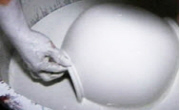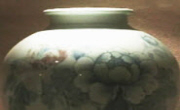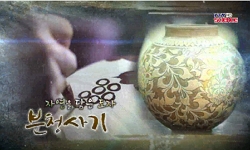Punch'ong ware which began to be made since early Chosun dynasty may well have formed a great mainstream in the history of Korean porcelains. It developed from "Sanggam" Celadon during Koryo dynasty, but its aesthetic sense was quite differ...
http://chineseinput.net/에서 pinyin(병음)방식으로 중국어를 변환할 수 있습니다.
변환된 중국어를 복사하여 사용하시면 됩니다.
- 中文 을 입력하시려면 zhongwen을 입력하시고 space를누르시면됩니다.
- 北京 을 입력하시려면 beijing을 입력하시고 space를 누르시면 됩니다.
https://www.riss.kr/link?id=T8454634
- 저자
-
발행사항
서울 : 淑明女子大學校, 2001
-
학위논문사항
학위논문(박사) -- 숙명여자대학교(대학원) , 미술사학과(한국미술사전공) , 2001. 8
-
발행연도
2001
-
작성언어
한국어
- 주제어
-
KDC
631.21105 판사항(3)
-
DDC
631.21105 판사항(15)
-
발행국(도시)
서울
-
형태사항
280 p. : 삽도, 도판 ; 26 cm
- 소장기관
-
0
상세조회 -
0
다운로드
부가정보
다국어 초록 (Multilingual Abstract)
Punch'ong ware which began to be made since early Chosun dynasty may well have formed a great mainstream in the history of Korean porcelains. It developed from "Sanggam" Celadon during Koryo dynasty, but its aesthetic sense was quite different from the inlaid celadon. In particular, on the threshold of 15th century when porcelains began to be distributed widely, Punch'ong ware were more widely used. The climax of Punch'ong development was during King Sejong's reign. However, an official kiln was established in Kwangju, Kyonggi-do later, while the royal family and administration offices began to prefer the white porcelain. After all, Punch'ong ware began to be localized with their unique forms, and its production began to decrease gradually. As the surface of the porcelain changed from blue green to white with no
patterns, Punch'ong ware would be absorbed by the white porcelains. Thus, around mid-17th century after the Japanese invasion, Punch'ong ware which had prospered for about 200 years during the early Chosun dynasty would disappear. Despite the fact that Punch'ong ware had developed from the
inlaid celadon during Koryo dynasty, it was quite different from the latter. Although its glazing process was similar to that of the inlaid celadons after the 14th century and its flower pattern inlaid could be explained within the scope of the inlaid celadons, its expression methods were quite different from the Koryo celadons. In addition, unlike the Koryo celadons, Punch'ong ware were not only possessed by the ruling class, which suggests that the aesthetic sense of Punch'ong ware was quite different. To be more
specific, although Punch'ong ware were used primarily by the literati class, they were made by the unknown humble people, and therefore, they were also used by commoners. In this process, the sense of folklore art could be introduced into Punch'ong ware. In other words, despite the ruling class's aesthetic value was reflected on Punch'ong ware, it was also favored by the ruled class. Thus, the aesthetic sense of Punch'ong ware cannot be dichotomized into ruling and ruled classes', which is too important to be overlooked. Because such artifacts departed from the conventional form, being even unique and irregular, they may provide us with some important clues to review commoners'
aesthetic sense. Such commoners' items as earthenwares and clay figures during Shilla Kingdom, Punch'ong ware during early Chosun dynasty, and the "iron-powdered" white porcelain and folk paintings during late Chosun dynasty are our valuable cultural assets showing the then commoners' aesthetic sense.
Any study of the aesthetic consciousness or sense of Punch'ong ware must be an attempt based on the aesthetics as well as in view of the art history. Namely, it may well be most ideal to analyze the characteristics of celadon's forms and review its aesthetic phenomenon including the aesthetic essence and consciousness against its historic background. Then, how should we interpret or define the term of "aesthetic sense" or "aesthetic consciousness" for our traditional art? In fact, it seems to be
difficult to classify out an aesthetics because it forms an inseparable part of art as far as our traditional art is concerned, because our traditional art was based on a high-degree conceptual
thought. Therefore, the aesthetic classifications developed for the Western art cannot well be applied to such humble people's works as Punch'ong ware during Chosun dynasty, since it featured a folk art which cannot be well defined academically. So, in this study, the term "aesthetic sense" instead of "aesthetic consciousness" would be used. The term covers the aesthetic experiences in the widest sense of the word.
After all, the term "aesthetic sense" is not only limited to the theoretical or academic aesthetics but also applied to the beauty sense connoted by literature, art or social phenomenon in order to
analyze the essence of the aesthetic thoughts inherent therein. Therefore, the term may be able to explain the changes of aesthetic thoughts in a scientific way, and in this regard, the term "aesthetic sense" may surmount the limits imposed by the term "aesthetics". In particular, when an aesthetic sense is discussed in Korea or China, it is understood generally in association with an ultimate condition or nature or "Tao". If we can say that the phenomenon perceiving the object of Punch'ong ware is called "aesthetic sense", we can understand it in any way. So, the term "aesthetic sense" can be legitimate in
this sense. The aesthetic consciousness of Punch'ong ware may well be equated with the discussion about its characteristics or features. Owing to the development of new decoration techniques, Punch'ong ware became diverse, causing an aesthetic sense. Its patterns continued to be transformed or omitted but looked sufficiently aesthetic. Unlike the blue green or white porcelains, Punch'ong ware were localized to be used by commoners, and in this process, a native culture was formed by the ceramists and
vice versa. Namely, religion, thoughts, natural environment and culture may have affected their world of consciousness. The ceramists' temper or culture formed as such may have affected the aesthetic sense of Punch'ong ware. After all, we can witness randomization, naturalization and playfulness and abstraction in Punch'ong ware. 1) Randomization might result from non-refinedness or
indifference. However, such a phenomenon can be traced ultimately to "oneness of heaven and man" or the "three religions"(Taoism, Buddhism and Confucianism). Ceramists made their products being influenced, though vaguely, by such thoughts or religions. 2) The aesthetic consciousness acquiescent to the natural
environment may be equated with naturalization, and the view of nature or the folk belief might be reflected on the celadon makers' mind. The naturalization may be shown by the shape and patterns of Punch'ong ware. 3) The localization of Punch'ong ware may have led to the aesthetic sense of "playfulness". It can be estimated that Punch'ong ware came to be localized by folk life style and culture. Like other folk arts, the aesthetics of "playfulness" can be traced back to Punch'ong ware.
4) Here, the abstraction was a result from a highly imitative conception. Since the pre-historic age, the Korean people's culture has tended to be abstract. Punch'ong ware was not an exception. It was a play and at once an abstraction.
국문 초록 (Abstract)
분청사기는 조선시대 전기에 형성되어 한국 도자사의 커다란 주류(主 流)를 이룬 하나의 맥이었다. 그것이 비록 고려 상감청자를 모태로 변모 발전하였으나, 미의 방향은 뚜렷이 달랐다. ...
분청사기는 조선시대 전기에 형성되어 한국 도자사의 커다란 주류(主
流)를 이룬 하나의 맥이었다. 그것이 비록 고려 상감청자를 모태로 변모
발전하였으나, 미의 방향은 뚜렷이 달랐다. 특히 15세기가 되면 자기(磁
器)가 생활화됨에 따라 분청사기는 크게 확산되는 계기를 맞았으나, 그
후 경기도 광주의 관요가 형성되어 왕실과 관청에서 자기의 사용이 백자
로 자리잡기 시작하자 분청사기는 점차 지방 양식화되어 독특한 기법으
로 변모되게 된다. 그러나 본격적인 백자의 등장과 임진왜란을 계기로
14세기 중엽이후 약200여 년간 조선 전기를 풍미한 분청사기는 자취를
감추게 된다.
분청사기의 표현양식은 비록 이들의 유약 처리가 14세기 이후 상감청
자와 같고 또 인화분청(印花粉靑)을 상감청자의 범주에서 설명한다고 하
여도, 고려시대에는 상상할 수도 없을 정도로 일탈된 모습인 것이며 또
한 전혀 차원이 다르다. 뿐만 아니라 회화나 조각처럼 일부 지배계층의
전유물만이 아니었다는 점은 분청사기의 미의식을 도출하는데 매우 중요
한 요소이다. 즉 분청사기가 상류계층에서도 쓰여졌으나 그것을 만든 도
공들은 이름 모를 민중들이었고, 또한 일반 서민들의 용기로 사용되었다
는 점에 주목하게 된다. 이러한 과정 속에서 민예적인 감각이 삽입되고
민중들의 진솔한 미의식이 담긴다. 말하자면 상류사회의 안목이 작용했
다는 점을 인정한다 하더라도 분청사기처럼 중 하층의 미의식이 상하계
층을 막론하고 선호되었다는 점은 상류와 하류라는 이분법만으로 가릴
수 없는 그 본질적인 미의식을 담고 있다는 점에서 매우 중요한 부분인
것이다. 이러한 미술품들은 너무도 기존의 양식에서 일탈하고 있으며, 의
외적이고 또 파격적이어서 대대로 한 줄기 맥을 형성한 서민들의 미의
전형(典型)을 볼 수 있게 된다.
분청사기에 나타나는 미의식(美意識) 또는 미감(美感)의 문제를 탐구
하는 일은 먼저 미술사에서 도자기의 양식적 특색(樣式的特色)을 분석하
여 다양한 역사적 현상을 바탕으로 하고, 미학에서의 미(美)의 본질이나
미의식을 포함한 미적 제반현상(美的現象)을 그 본래의 영역에서 다루는
것이 가장 이상적일 것이다. 그러나 한국미술을 대상으로 밝혀 낸 미학
의 용어로서 '미감'이나 '미의식'의 개념을 어떻게 정리하고 해석해야 하
는가 라는 문제가 남게 된다. 한국적인 미학의 분류는 그것이 고도의 관
념적 사고에 의한 미의식이 기본체제인 것처럼 보이는 부분에 있어서 그
분류가 사실상 어렵다고 볼 수 있다. 또한 이러한 분류가 가능하다고 하
여도 미학적 분류는 서구적이어서, 조선시대의 분청사기와 같이 주로 천
민과 같은 지위에 있던 장인들이 만들어 낸 민예적 성격에 적용시키기에
는 지나친 경향이 있게된다.
그러므로 분청사기에서 사용한 '미의식(美意識)', '미감(美感)'이란 용어
조차 그 자체가 오히려 학문적이라 할 수도 있겠으나, 본고에서는 단지
한국의 정서에 기인하는 미적인 해석으로서 편의상 미감이라 정리하고자
한다. 따라서 분청사기에 사용되는 미감이란 용어의 의미는 광의의 미학
에 속해 있는 미적 체험을 지칭하는 것이라 할 수 있다. 말하자면 심미
의식 즉 미감(美感)은 이미 다소간의 이론형태를 갖춘 미학사상에 국한
되지 않고, 각 역사시대의 문학, 예술 및 사회 풍상(風尙)중에 표현된 심
미의식에 대하여 전면적인 고찰을 진행시켜 그 중에 내포된 미학사상의
실질을 분석하고 동시에 그의 변천에 대하여 과학적인 설명을 가질 수
있어야 하기 때문에 미학이란 용어의 사용에서 오는 한계점을 극복하고
대체시킬 수 있는 용어라 할 수 있다. 특히 한국이나 중국에서 미의식을
논할 때는 대체로 미(美)나 예술의 궁극적인 경지 혹은 근원을 자연(自
然)이나 도(道)와 연계하여 이해되고 있다는 점을 고려할 때 더욱 그러
하다.
분청사기에 있어서 대상을 자각하는 현상을 미의식이라고 한다면, 분
청사기를 어떤 식으로든지 이해한 상태를 특성 또는 특질로 인식할 수
있기 때문에, 이를 논의하는 것을 바탕으로 '미감'의 도출이라는 명제는
충분히 그 체제를 갖출 수 있게 된다. 따라서 분청사기의 미의식은 먼저
분청사기의 특성 또는 특질로 논의되어 질 것이다.
분청사기는 새로운 분장법의 개발로 인하여 여러 가지 기법이 개발된
다. 이러한 기법에 따른 특징이 새로운 미감을 일으키는 주 요인으로 작
용한다. 문양에서는 주로 어느 하나의 소재가 집중적으로 끊임없이 변용
되거나 생략되어 변모를 갖게 되는 양상을 분류해 볼 수 있고 그 속에서
미감을 추출하는 것이 가능하다. 또한 분청사기는 청자·백자와 달리 지
방 양식화하면서 서민용기로 확산되는데 이러한 과정에서 지방의 토착적
인 문화가 도공들의 심성으로 형성되었고, 이때 그들의 성정(性情)에 영
향을 주었을 것이라고 판단된다. 종교·사상·자연환경·문화 등은 도공
들의 의식세계에 다양하게 영향을 미쳤을 것이다. 이와 같은 그들의 기
질적 성정은 조형감각에 근본적으로 영향을 끼치면서 분청사기에서는 무
작위성, 자연성, 유희성, 추상성 등으로 표출되게 되었다.
1) 무작위성(無作爲)은 조형적으로 보면 비정제성이자 무관심성의 결
과일 것이다. 그러나 이러한 조형결과를 가져올 수 있도록 하였던 근원
적인 사상을 추론하자면, 천(天)과 합일하려는 인(人)의 자연사상, 그리
고 또 선(禪)과 불교적인 사유정신을 비롯한 삼가(道家,佛,儒)사상이 대
두되어 그들의 정신과 의식세계 속에서 조형수법의 직·간접적 근간으로
생각할 수 있다.
2) 자연환경에 따르는 미의식은 자연성을 형성하였으며, 민간신앙 속
의 자연관은 그대로 조형미술에 반영되었다. 그 결과 분청사기에는 하나
의 양식적 특징으로서 자연성은 그릇의 성형과 문양이라는 전과정을 통
해서 살아 나온 것이다.
3) 분청사기의 지방적인 특색은 유희성이라는 미감으로 승화되고 있었
다. 즉 그 지방에서 대대로 삶을 유지한 민중들의 생활과 문화 속에서
분청사기는 지방양식을 생성시키고 있었던 것으로 추론이 가능하다. 따
라서 타 장르의 예술 형태를 비교하면서 분청사기의 미의식이 유희미로
승화되고 있음을 살펴볼 수 있다.
4) 추상성은 고도의 사의적 관념(寫意的觀念)으로 이루어 낸 추상이다.
선사시대 이래 기질적으로 한민족은 추상성향에 대한 시각과 감흥을 띤
다면, 이러한 일반 민중적인 기질은 분청사기에서도 그대로 표출되어 유
희이자 추상이요, 추상이자 유희로서의 추상성에 이르고 있음을 알 수
있다.












